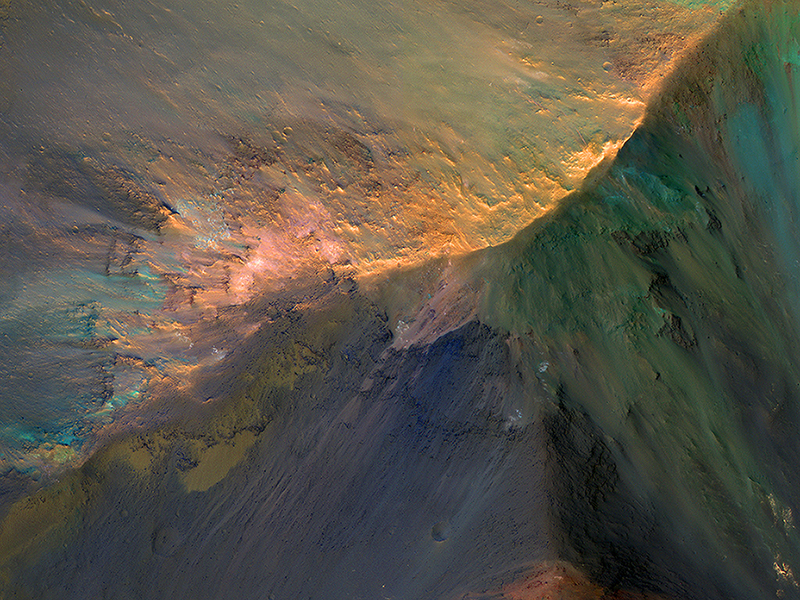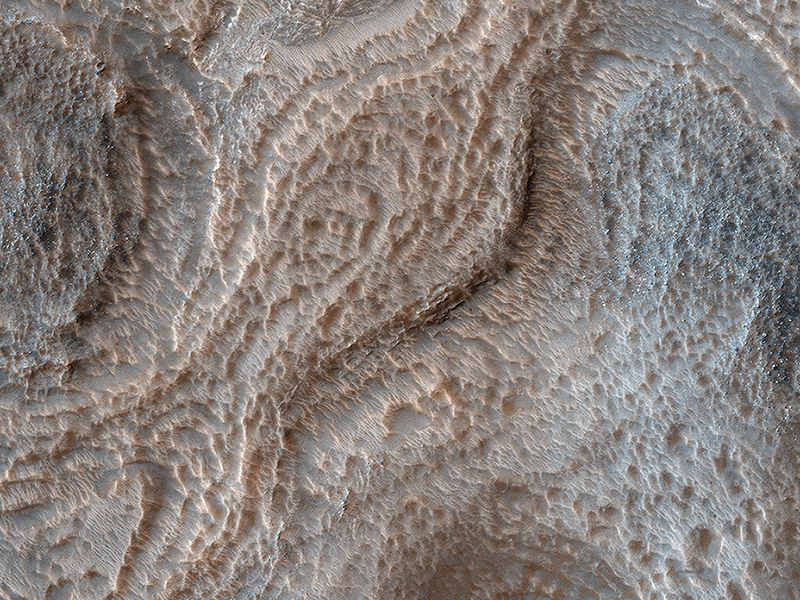HiRISE Updates Week of 2017 Mar 20
Posted: Fri Mar 24, 2017 5:07 pm
Alfred McEwen wrote:The Hills are Colorful in Juventae Chasma (ESP_049045_1760) (HiClip)
There are many hills about 1 kilometer high in Juventae Chasma, which is located north of the main Valles Marineris canyon system. The floor of the canyon is covered by a sea of sand, but the hills rise above the sand. A few adventuresome sand dunes have slowly climbed up on the hills, like that near the upper left of the enhanced-color cutout.
The color diversity here is exceptional, due to varying mineral compositions and good exposures.
Alfred McEwen wrote:Gullies in Winter Shadow (ESP_049058_2360) (HiClip)
This is an odd-looking image. It shows gullies during the winter while entirely in the shadow of the crater wall. Illumination comes only from the winter skylight.
We acquire such images because gullies on Mars actively form in the winter when there is carbon dioxide frost on the ground, so we image them in the winter, even though not well illuminated, to look for signs of activity. The dark streaks might be signs of current activity, removing the frost, but further analysis is needed.
NB: North is down in the cutout, and the terrain slopes towards the bottom of the image.
Sharon Wilson wrote:To Great Depths (ESP_049330_1425) (HiClip)
Hellas is an ancient impact structure and is the deepest and broadest enclosed basin on Mars. It measures about 2,300 kilometers across and the floor of the basin, Hellas Planitia, contains the lowest elevations on Mars.
The Hellas region can often be difficult to view from orbit due to seasonal frost, water-ice clouds and dust storms, yet this region is intriguing because of its diverse, and oftentimes bizarre, landforms.
This image from eastern Hellas Planitia shows some of the unusual features on the basin floor. These relatively flat-lying “cells” appear to have concentric layers or bands, similar to a honeycomb. This “honeycomb” terrain exists elsewhere in Hellas, but the geologic process responsible for creating these features remains unresolved.
Matt Chojnacki wrote:Dunes of the Southern Highlands (ESP_049371_1380) (HiClip)
Sand dunes are scattered across Mars and one of the larger populations exists in the Southern hemisphere, just west of the Hellas impact basin. The Hellespontus region features numerous collections of dark, dune formations that collect both within depressions such as craters, and among “extra-crater” plains areas.
This image displays the middle portion of a large dune field composed primarily of crescent-shaped “barchan” dunes. Here, the steep, sunlit side of the dune, called a slip face, indicates the down-wind side of the dune and direction of its migration. Other long, narrow linear dunes known as “seif” dunes are also here and in other locales to the east.
NB: “Seif” comes from the Arabic word meaning “sword.”
Credit: NASA/JPL-Caltech/University of Arizona
<< Previous HiRISE Update



